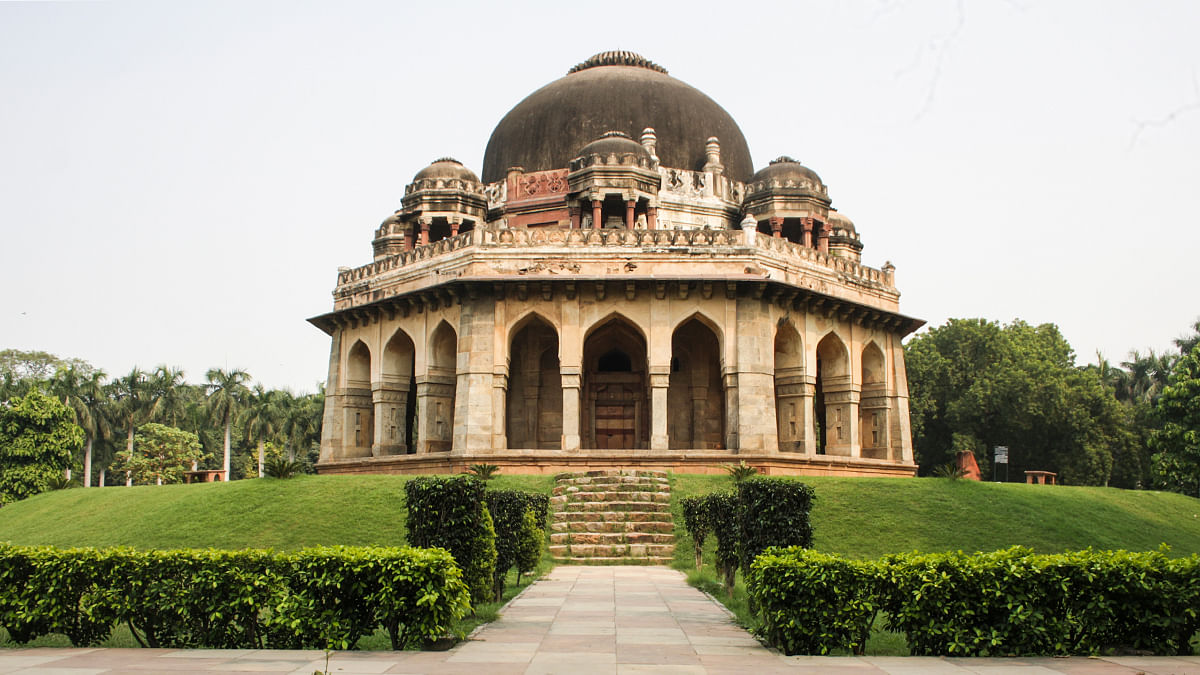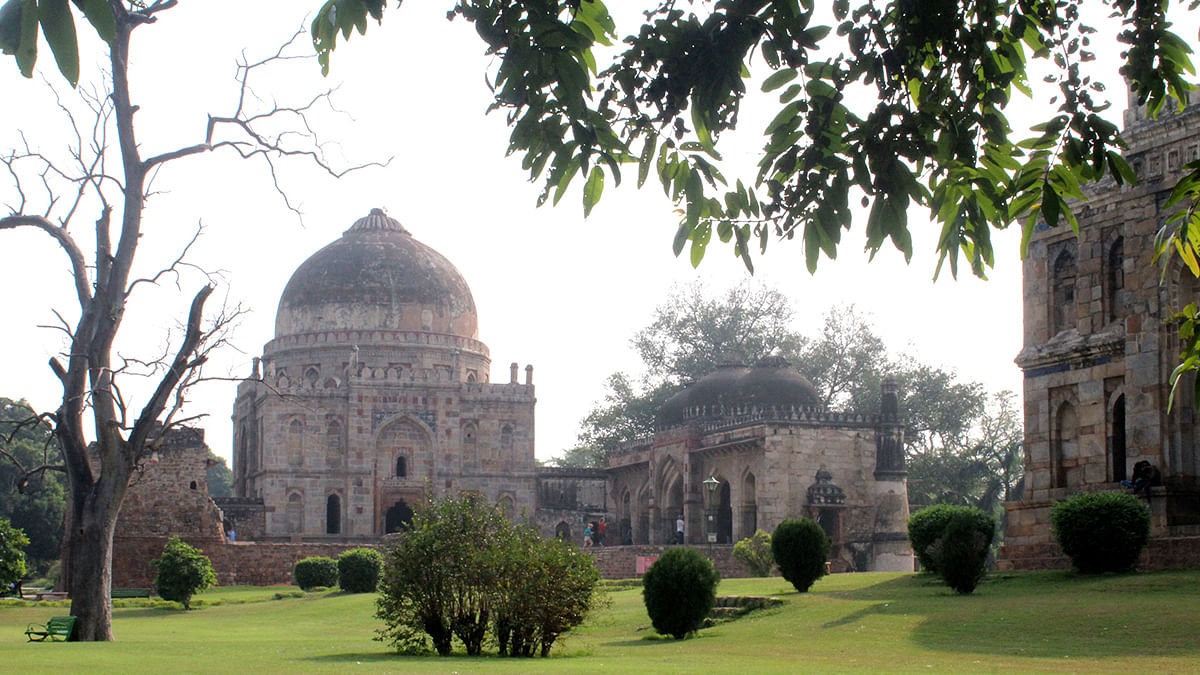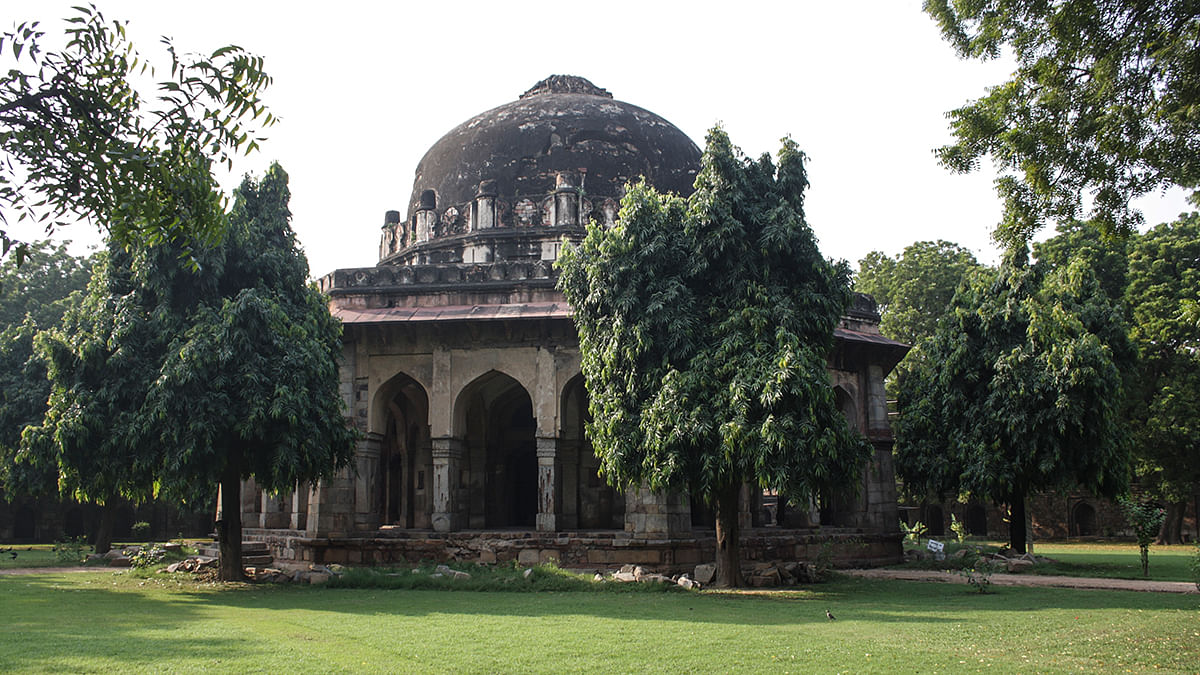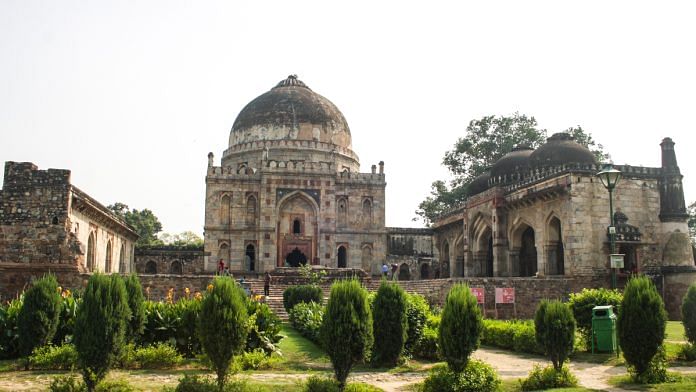A 90-acre garden complex situated in New Delhi, India, the Lodi Gardens is comprised of tombs, mosques and other structures commissioned by members of the Sayyid, Lodi, and Mughal dynasties from the mid-fifteenth century onwards. The most significant additions to the complex, the Bada Gumbad, and the Shish Gumbad were made during the reign of Sikandar Lodi (r. 1489–1517), and the place was named after his dynasty following the independence of India in 1947. Scholars believe that the choice of this site was made by three different ruling families because of its proximity to the Nizamuddin Dargah, the burial site of Khwaja Nizamuddin Auliya, a venerated thirteenth-century Sufi saint.
Lodi Gardens has a number of entry points and four official gates. At the southern end of it is the tomb of Muhammad Shah Sayyid (r. 1434–45) of the Sayyid dynasty, while at the northern end lies the tomb of Sikandar Lodi of the Lodi dynasty. In its centre lies a number of other structures such as the Bada Gumbad, with its adjacent mosque and mehman khana (guesthouse); a turret that scholars speculate is the oldest structure in the complex; and the Shish Gumbad.
The tomb of Muhammad Shah Sayyid, commissioned by his son and successor, Alauddin Alam Shah (r. 1445–51), is one of the few surviving structures remaining in India that was built by the Sayyids and dates to c. 1445. Including the plinth, the structure is 25 metres wide and is built on a raised mound of 40 metres that is traversed by a flight of stairs. It has an octagonal plan with three archways on each side and an arcade that goes around the open tomb chamber. Notable features include buttressed corners, discharging arches, decorative incised plasterwork on the ceiling and chhatris (domed pavilions) on the roof, surrounding the dome.
The dome is capped by an inverted lotus finial. A circular gallery of arched niches, four of which are windows, line the base of the dome. The interior of the tomb contains the grave of the ruler as well as other graves, presumed to be those of his family members. The octagonal shape of the tomb borrows from the architectural conventions of Shia tombs, attesting to the sect’s influence in Delhi during the reign of the Sayyids.The subsequent construction of tombs in the vicinity of this one suggests the use of the space as a marker of continuity between different rulers of the Delhi Sultanate, leading to the eventual formation of a tomb complex.

The Sayyid tomb is separated spatially and chronologically from another complex of structures, consisting of the Bada Gumbad, the Bada Gumbad Masjid, and the Shish Gumbad, all of which are believed to have been constructed in the late-fifteenth century, by Sikandar Lodi.
The Bada Gumbad, meaning ‘large dome’, resembles a tomb but there are no graves within it. It has two entrances, one facing north, towards the Shish Gumbad, and another on the west, leading to an empty area. The structure has two tiers of decorative arches and a large arched entrance, but is otherwise unadorned. Its plinth extends to the north into a courtyard flanked by two long structures. The western building is a mosque which, because of its attachment to the Bada Gumbad, is known as the Bada Gumbad Masjid. The unadorned eastern structure mirrors the dimensions of the mosque but has three arched entrances and is unadorned. This is known as the majlis khana or mehman khana, and may have been used as a cloister for a madrassa. Scholars believe that the Bada Gumbad was designed as an entryway to the mosque.
The mosque is a small arcade-like structure that is entered from the courtyard through five arches, the central one being the largest and most heavily ornamented. A bracketed cornice runs along the face of the structure, interrupted by the pishtaq, or square frame, around the central arch. Three domes with lotus crest finials surmount the structure, supported by vaults formed between the three central bays and the qibla wall. This wall is thereby divided into five arches, each of which in turn houses sets of three arched niches. The central niche of each of these is crowned by a small but ornately carved arch.
Similar arches line the base of each dome on the inside, imitating a circular gallery. The squinches, spandrels and edges of all the arches are covered in incised and painted limestone plasterwork, which came to be a distinctive decorative feature of Lodi-era mosques. The decoration largely takes the form of calligraphy of Quranic verses and, to a lesser extent, patterns of small floral and geometrical motifs, though some portions of this carved layer have broken and fallen off over time. The mihrab bears an inscription that dates the mosque to 1494
Also read: From Bidar to Telangana – How Bidriware began and evolved with the times
On the eastern side of the Bada Gumbad is a rubble masonry turret, unrelated to any of the tombs, on a plinth that is believed to be a later addition to the edifice. Scholars believe that the turret was originally part of a larger structure which is no longer there. A ribbed dome on its roof and a projecting jharokha window on one side are its only notable features. With no surviving staircase or any designated area for one, its original purpose remains unclear.
The Shish Gumbad, meaning ‘glazed dome’, is named for the bright turquoise and cobalt-glazed tiles on the upper portion of its entrance. Fashioned out of stone, the Shish Gumbad follows conventions of Lodi tomb architecture. The tomb is cubical and double-storeyed. It has a single entrance on its southern side which leads to the inner chamber containing seven large cenotaphs, accompanied by a small one. There are no inscriptions indicating the identities of those buried within, but considering its sizable proportions, some scholars have suggested that Bahlul Lodi (r. 1451–89), the first Lodi ruler, is buried in it. Others have argued that it might be another member of the royal family.

The northern end of the Lodi Gardens contains the tomb of Sikandar Lodi, built by his son Ibrahim Lodi (r. 1517–26). The walled garden courtyard around the tomb has an elaborate gateway at its south, from which a path leads to the tomb. Outside this gate is a raised forecourt where two standalone chhatris are placed on either side. A large arched mihrab, the same size as the southern gate, is placed on the western side of the garden’s boundary wall, suggesting that the space around the tomb may have doubled as an open-air mosque. The tomb resembles Muhammad Shah Sayyid’s mausoleum but does not have chhatris on top. The entrances, with three plain arches on each side, are covered by a bracketed cornice carved out of red sandstone into kalasha designs. Inside the tomb, the arches and windows of the circular gallery along the dome’s drum are decorated with green and blue enamelled tiles. The tomb has a double-dome, with the inner layer serving as a ceiling for the tomb and the upper layer serving as the building’s crown. This architectural innovation was subsequently incorporated into Mughal construction. The upper portion of the dome is decorated with incised plasterwork patterns.
The construction of grand tombs in this area by the Lodis may have been an exercise in consolidating and elevating their lineage. Considering that the dynasty traced its origins to horse traders, these large, ornate structures — particularly the tomb of Sikandar Lodi — may have served to establish a continuity between them and the aristocratic Sayyid dynasty.

The northern part of the Lodi Gardens also contains monuments built under Mughal rule. One of these is the Athpula, an eight-pier bridge built during the reign of Akbar (r. 1556–1605), over a canal that originally connected to the River Yamuna and was later provided with a man-made reservoir. The Mughals also constructed a small complex consisting of a gateway, mosque and garden. The two-storeyed gateway has a triple-arched entrance. The mosque has a single chamber and is crowned with three domes. There is a courtyard on its eastern side, with the garden positioned in front of it.
Prior to the urban redesigning of Delhi by the British in the early twentieth century, these structures lay in an area that was part of a village on the banks of the river Yamuna called Khairpur. In 1936, following the formation of New Delhi as an extension of the city, the residents of Khairpur were evacuated and the region was integrated as Lady Willingdon Park, named after the wife of the then-Viceroy of India, Freeman Freeman-Thomas, the Marquess of Willingdon. The tombs were consolidated as a single complex and a large number of native and foreign trees were planted around the monuments while pathways were constructed, giving the place the shape of a park. Following the independence of India, it was named as Lodi Gardens. In 1968, American modernist architect, Joseph Allen Stein, re-landscaped the complex, adding an artificial lake with a fountain and a glass house for storing plants. Stein’s remodelling gives the complex its present day shape. The garden of the Mughal-era mosque now serves as the Rose Garden which houses a variety of English roses. In 1996, the India Bonsai Association helped in setting up the National Bonsai Park next to Gate No.1 of Lodi Gardens — a paved section dedicated to the display of a large variety of bonsai trees. In 2010, all of the complex’s monuments were restored by the Indian National Trust for Art and Cultural Heritage (INTACH).

Today, Lodi Gardens is a major tourist attraction, and its sprawling greenery makes it a key biodiversity spot in New Delhi. It is also heavily frequented by locals as a park and is an important part of the city’s heritage. Entry into it is free and open from early morning to late in the evening, with shifting timings based on seasons. The locality around Lodi Gardens is known as the Lodi Estate — it is an affluent neighbourhood dotted with cultural and international institutions such as the India Habitat Centre, the India International Centre, and the Alliance Francaise amongst others.
This article is taken from the MAP Academy‘s Encyclopedia of Art with permission.
The MAP Academy is a non-profit, open-access educational platform committed to building equitable resources for the study of art histories from South Asia. Through its freely available digital offerings—Encyclopedia of Art, Online Courses, and Stories—it encourages knowledge-building and engagement with the visual arts of the region.






